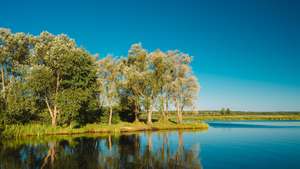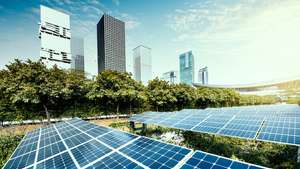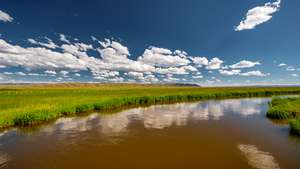
Assessment and forecast of technogenic pollution impact on the mineral composition of surface waters of Ukraine.
 Tatyan Kotova 1*
Tatyan Kotova 1*
1Kyiv National University of Construction and Architecture, Povitroflotsky Avenue, 31, Kyiv, 03037, Ukraine
Received: 03/10/2018, Accepted: 03/18/2018, Available online: 03/20/2018.
DOI: https://doi.org/10.32557/useful-2-1-2018-0002
HDL: http://hdl.handle.net/20.500.12334/43
*Corresponding author: e-mail: tvk-5@ua.fm
Under a creative commons license. Volume 2, Issue 1, 2018, pages: 10-19.
Author Keywords: water-surface ecosystems, technogenic deformation, hydrochemical parameters, total mineralization
ABSTRACT
The assessment and forecasting of the quality of water sources that can be suitable for public water supply and the implementation of the principles of the Water Framework EU Directive 2000/60 / are of great importance on the threshold of the third millennium. The rationale of the research stems from the fact that at the current stage of development of commercial public water supply systems, 70% of water use in Ukraine is provided from surface sources (the EU average is 20%). According to existing standards, all major rivers of our country, as well as their main tributaries, are considered to be "polluted" and "very polluted".It became extremely urgent to study the stages of long-term changes in the mineralization index in the aquatic ecosystem under the influence of external factors and to obtain dependencies to determine the maximum value of the mineralization index, which can be accumulated in the aquatic ecosystem, and time needed for the lake or river system to achieve the new stage of technogenic equilibrium.
The determined regularities may form the basis for justification of the maximum allowable water loads for different regions of Ukraine to ensure their adequate level of environmental safety, and to improve the work efficiency of water treatment facilities. The assessment and forecasting of the technogenic pollution impact on the mineral composition of surface waters of Ukraine is carried out.
Introduction
A number of authors: Hopchenko E.D., Severna N.I., Korzh A.M have been actively engaged in the study of changes in the mineralization of surface waters in the area of drinking water intake in the city of Bolgrad since the early 1970's. Based on the results of the research conducted, it has been concluded that the quality of water in the Yalpugh Lake, especially in the area of the Bolgrad water intake, is characterized by the dependence on the natural factor - the mineralization of groundwater, discharged into the lake basin rather than by the dependence on anthropogenic loads. According to the results of chemical analysis from wells, evenly spaced along the perimeter of the Kugurlui and Yalpugh lakes, it makes on average of 2.6 g / dm3.
Several aquatic ecosystems were selected to do research in various natural and climatic zones of Ukraine: the dry arid zone of the steppe - Lake Yalpugh, the Bolgrad water intake; Polissya Zone - the Irpin river, Mostysche village and the Desna River; Letky village; the western forest steppe zone - Poltva river, the city of Busk; Donetsk-Dnipro region – the Samara river, Novomoskovsk; Kaluski Mining District, Pre-Carpathian Region – the Limnitsa river.
It is determined that although the increase in technogenic changes is due to the influence of various load factors (irrigation in the arid Steppe area, mining pits closure and the reduction of water pumping in high salinity mines in Donbass, etc.), the nature of these factors is the same (Figure 1) and is adequately described by the asymmetric distribution curve of Pearson III genus.

It is determined that the equation of surface water mineralization growth with account of the component of the level of disturbance of the stable functioning for a particular year () is most accurately described by the law:

The section contains a mathematical model to determine the relation between water system mineralization level and the indices that characterize the degree of disturbance.
In an integral form, the equation (1) is represented by the dependence:

The disturbance component has been determined as the difference of the integral over Ci according to equation (2) and the average value C0 of the surface water mineralization in previous years of observation (when the system does not experience significant anthropogenic impact and has hydrochemical parameters close to the natural background). For rivers that have already acquired the stage of anthropogenic equilibrium, the value of the mineral composition disturbance component can be determined according to the equation:

When calculating the value of the component of the level of technogenic contamination disturbance on the mineral composition, the Simpson method was used as one of the most accurate approximate methods.
Calculated using the formula (4), the annual average component of change in the surface water mineral composition (R) was compared to the value received by the method of long-term statistical observations treatment. Error in the calculations was 9%, which is within satisfactory limits.
The influence of subsurface water flow on the degree of land surface water disturbance under the conditions of the level of technogenic load on violation of water bodies sustainable development has been determined.
The functional relation between the values of relative mineral composition disorder (CT),value of the coefficient of subsurface water flow (M), the relation of total river flow (W) with extreme values of water content is proposed to be determined by correlation dependencies that reflect the direct impact of groundwater inflow on the increase in the level of technogenic load to the sustainable functioning failure of the river basins of the regions:

where Mmin and Mmax and Wmin and Wmax are the minimum and maximum values of subsurface waterflow coefficients and the values of the minimum and maximum relation of the total river flow respectively, which characterizes two periods - flood and bound one.
The value, which is determined by the formula (5):

is taken as the value of relative mineral composition disturbance of surface waters.
where Cr is the predominant over the initial one level of mineralization which has occurred at least in the last ten years in the section considered (Ci).
The author offers to describe stages of the mineralization index growth for various water bodies by general system of equations:

where Ci, Co, and Cmax are surface water mineralization of the object at some point and, prior to the technogenic impact, the maximum mineralization index before new stage of sustainable development of the system mg / dm3 , respectively;
Kn and Kз/ - coefficients that characterize the rise and decrease of the total of ions in water, respectively (mg / dm3) / per year.
Stages of long-term changes of the mineralization index in the aquatic ecosystem under the influence of external factors are as follows:
According to the results of the research, the dependencies presented in Fig. 3 and 4.


This approach will allow to determine the equation of mineralization content rise in the surface water for different natural and climatic zones using a long-term database of hydrochemical indices:

Simultaneous solution to the equations of the written system will allow us to find tm, that is, time when water system acquires the value of maximum external impact:

Ecosystem stabilization time tk after reaching its maximum limit of impact is determined by the formula:


The results obtained allowed to calculate the degree of disturbance of water-surface ecosystem sustainable functioning in different climatic zones according to the mineralization index, the time when it reaches the maximum value of the mineralization index and the technogenic level of hydro chemical stabilization. It is proved that the maximum value of the latter index depends on the main regime forming and resource factors rather than on the weakening of anthropogenic load on the system.
Conclusions
- The of changes in the mineral composition of land surface waters have been assessed and forecast, depending on the anthropogenic load on various natural and climatic zones of Ukraine.
- The research has been carried out in the area of public water intakes of the lake of Yalpugh - Bolgrad water intake and the Desna river in Letki village, which showed that an increase in the mineralization level by sanitary-hygienic standards for drinking water intakes DSANPiN No. 136/1940, DSTU 4808: 2007 was observed in the surface waters near the city of Bolgrad (Lake Yalpuh), in 2001-2003. The author states that since 2001 the ecosystem of Yalpugh lake has been in the stage of a new technogenic equilibrium with an average annual level of mineralization of surface waters being 1200 mg / dm3.
- The long-term dynamics of surface water mineralization for typical water bodies in the main natural-climatic zones of Ukraine with different levels of water supply and water use as an indicator of technogenic impact on them has been established. It is shown that this dynamic can be described by the asymmetric distribution curve of Pearson of the third genus.
- New generalizations on the influence of ground water inflow and the ground water runoff component on the level of the surface water mineral composition disorder have been made. It has been proved that ground water runoff plays an essential role in restoring sustainable development of the system. The statistical dependencies between the level of disturbance of water-surface ecosystems sustainable development under extreme values of water content for different natural-climatic zones of Ukraine and the values of the ground water runoff of the territory (M) and mutual coupling factor of surface and groundwater (Кв) are proposed.
- The dependencies to achieve the time of maximum value of the total mineralization index by the land surface water and the time of the new technogenic stage of the ecosystem stabilization were determined. It is proved that the maximum value of the latter index depends on the natural regime forming factors rather than on the weakening of anthropogenic pressure on the system.
References
[1] “Surface water quality assessment of the Desna river and Desnianskyi water intake, Kyiv region” - S. Voloshkina, N.M. Chajkovsjka, T.V. Kotova, O.Gh. Lysjuk. - Naukovyj visnyk budivnyctva. - Kh.: KhDTUBA KhOTV ABU, 2002. - # 19. – p..205-214.
[2] Analysis of long-term trends in surface water quality change in public water supply intake of Bolghrad city, Odessa Region O.S. Voloshkina, N.M. Chajkovsjka, T.V. Kotova, O.Gh. Lysjuk. – Ecology and Resources - - № 8. – p. 32-39.
[3] Kotova T.V. “Assessment of technogenic transformation level of surface water ecosystem of Ukraine”. - V. Kotova, O.S. Voloshkina, Je.O. Jakovlev. - Ecology and Resources – Institute of National Security Problems. – 2006. – № 14. - p.50-54.
[4] Kotova T.V. “Methodological foundations of determining the technogenic deformation level of water ecosystems for specific natural- agricultural zones of Ukraine. - V. Kotova, O.S. Voloshkina, Je.O. Jakovljev. - Environmental Ecology and Life Safety – Kyiv: Znannja. - 2005. – p. 39-43.
[5] Voloshkina O.S. ”Technogenesis impact on mineralization dynamics of surface waters of Jalpugh lake in area of Bolghrad intake”. - S. Voloshkina, T.V. Kotova, A.Ja. Poljovyj. - Ecology and Resources. - Institute of National Security Problems. - 2005. - № 11. – p.142-147.
[6] Voloshkina O.S. “Sustainability of ecosystems under technogenesis. - S. Voloshkina, T.V. Kotova. – Industrial Ecology. - Kharkiv: 2005. - №3 (4). - p.7-10.
Please cite as: T.Kotova “Assessment and forecast of technogenic pollution impact on the mineral composition of surface waters of Ukraine.” USEFUL online journal, vol. 2, no. 1, pp. 10–19, March 2018. DOI: https://doi.org/10.32557/useful-2-1-2018-0002







Comments